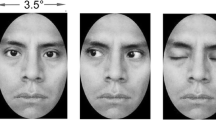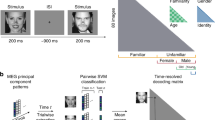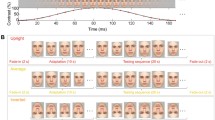Abstract
Using combined psychophysics and event-related potentials (ERPs), we investigated the effect of perceptual learning on face gender discrimination and probe the neural correlates of the learning effect. Human subjects were trained to perform a gender discrimination task with male or female faces. Before and after training, they were tested with the trained faces and other faces with the same and opposite genders. ERPs responding to these faces were recorded. Psychophysical results showed that training significantly improved subjects’ discrimination performance and the improvement was specific to the trained gender, as well as to the trained identities. The training effect indicates that learning occurs at two levels—the category level (gender) and the exemplar level (identity). ERP analyses showed that the gender and identity learning was associated with the N170 latency reduction at the left occipital-temporal area and the N170 amplitude reduction at the right occipital-temporal area, respectively. These findings provide evidence for the facilitation model and the sharpening model on neuronal plasticity from visual experience, suggesting a faster processing speed and a sparser representation of face induced by perceptual learning.




Similar content being viewed by others
References
Baker CI, Behrmann M, Olson CR (2002) Impact of learning on representation of parts and wholes in monkey inferotemporal cortex. Nat Neurosci 5:1210–1216
Ball K (1987) Direction-specific improvement in motion discrimination. Vis Res 27:953–965
Bentin S, Allison T, Puce A, Perez E, McCarthy G (1996) Electrophysiological studies of face perception in humans. J Cogn Neursoci 8:551–565
Berardi N, Fiorentini A (1987) Interhemispheric transfer of visual information in humans: spatial characteristics. J Physiol 384:633–647
Bi T, Chen N, Weng Q, He D, Fang F (2010) Learning to discriminate face views. J Neurophysiol 104:3305–3311
Campanella S, Chrysochoos A, Bruyer R (2001) Categorical perception of facial gender information: behavioural evidence and the face-space metaphor. Vis Cogn 8:237–262
Chen J, Liu B, Chen B, Fang F (2009) Time course of a modal completion in face perception. Vis Res 49:752–758
Desimone R (1996) Neural mechanisms for visual memory and their role in attention. Proc Natl Acad Sci USA 93:13494–13499
Di Russo F, Martinez A, Sereno MI, Pitzalis S, Hillyard SA (2002) Cortical sources of the early components of the visual evoked potential. Hum Brain Mapp 15:95–111
Erickson CA, Jagadeesh B, Desimone R (2000) Clustering of perirhinal neurons with similar properties following visual experience in adult monkeys. Nat Neurosci 3:1143–1148
Fahle M (2005) Perceptual learning: specificity versus generalization. Curr Opin Neurobiol 15:154–160
Fahle M, Edelman S (1993) Long-term learning in vernier acuity: effects of stimulus orientation, range and of feedback. Vis Res 33:397–412
Fendick M, Westheimer G (1983) Effects of practice and the separation of test targets on foveal and peripheral stereoacuity. Vis Res 23:145–150
Feng L, Liu J, Wang Z, Li J, Li B, Ge L, Tian J, Lee K (2011) The other face of the other-race effect: an fMRI investigation of the other-race face categorization advantage. Neuropsychologia 49:3739–3749
Fried I, Cameron KA, Yashar S, Fong R, Morrow JW (2002) Inhibitory and excitory responses of single neurons in the human medial temporal lobe during recognition of faces and objects. Cereb Cortex 12:575–584
Friston K (2005) A theory of cortical responses. Philos Trans R Soc Lond B Biol Sci 360:815–836
Furmanski CS, Engel SA (2000) Perceptual learning in object recognition: object specificity and size invariance. Vis Res 40:473–484
Gauthier I, Tarr MJ, Anderson AW, Skudlarski P, Gore JC (1999) Activation of the middle fusiform “face area” increases with expertise in recognizing novel objects. Nat Neurosci 3:568–573
Gauthier I, Skudlarski P, Gore JC, Anderson AW (2000) Expertise for cars and birds recruits brain areas involved in face recognition. Nat Neurosci 3:191–197
Gazzaniga MS, Smylie CS (1983) Facial recognition and brain asymmetries: clues to underlying mechanisms. Ann Neurol 5:536–540
Gilbert CD, Sigman M, Crist RE (2001) The neural basis of perceptual learning. Neuron 31:681–697
Goffaux V, Gauthier I, Rossion B (2003) Spatial scale contribution to early visual differences between face and object processing. Cogn Brain Res 16:416–424
Golby AJ, Gabrieli JDE, Chiao JY, Eberhardt JL (2001) Differential responses in the fusiform region to same-race and other-race faces. Nat Neurosci 4:845–850
Gölcü D, Gilbert CD (2009) Perceptual learning of object shape. J Neurosci 29:13621–13629
Gold JI, Watanabe T (2010) Perceptual learning. Curr Biol 20:R46–R48
Gold J, Bennett P, Sekuler A (1999) Signal but not noise changes with perceptual learning. Nature 402:176–178
Grill-Spector K, Kushnir T, Hendler T, Malach R (2000) The dynamics of object-selective activation correlate with recognition performance in humans. Nat Neurosci 3:837–843
Grill-Spector K, Knouf N, Kanwisher NG (2004) The fusiform face area subserves face perception, not generic within-category identification. Nat Neurosci 7:555–562
Grill-Spector K, Henson R, Martin A (2006) Repetition and the brain: neural models of stimulus-specific effects. Trends Cogn Sci 10:14–23
Harley EM, Pope WB, Villablanca JP, Mumford J, Suh R, Mazziotta JC, Enzmann D, Engel SA (2009) Engagement of fusiform cortex and disengagement of lateral occipital cortex in the acquisition of radiological expertise. Cereb Cortex 19:2746–2754
Hussain Z, Sekuler AB, Bennett PJ (2009) Perceptual learning modifies inversion effects for faces and textures. Vis Res 49:2273–2284
Itier RJ, Taylor MJ (2004a) Effects of repetition learning on upright, inverted and contrast-reversed face processing using ERPs. Neuroimage 21:1518–1532
Itier RJ, Taylor MJ (2004b) N170 or N1? Spatiotemporal differences between object and face processing using ERPs. Cereb Cortex 14:132–142
Jacques C, Rossion B (2007) Early electrophysiological responses to multiple face orientations correlated with individual discrimination performance in humans. Neuroimage 36:863–876
Jeter PE, Dosher BA, Petrov A, Lu Z (2009) Task precision at transfer determines specificity of perceptual learning. J Vis 9(3):1.1–1.13
Jiang X, Bradley E, Rini RA, Zeffiro T, VanMeter J, Riesenhuber M (2007) Categorization training results in shape- and category-selective human neural plasticity. Neuron 53:891–903
Johnston RA, Kanazawa M, Kato T, Oda M (1997) Exploring the structure of multidimensional face-space: the effects of age and gender. Vis Cogn 4:39–57
Karni A, Sagi D (1991) Where practice makes perfect in texture discrimination: evidence for primary visual cortex plasticity. Proc Natl Acad Sci USA 88:4966–4970
Kosslyn SM, Koenig O, Barrett A, Cave CB, Tang J, Gabrieli JDE (1989) Evidence for two types of spatial representations: hemispheric specialization for categorical and coordinate relations. J Exp Psychol Hum Percept Perform 15:723–735
Logothetis NK, Pauls J, Poggio T (1995) Shape representation in the inferior temporal cortex of monkeys. Curr Biol 5:552–563
McCarthy G, Puce A, Belger A, Allison T (1999) Electrophysiological studies of human face perception: II. Response properties of face-specific potentials generated in occipitotemporal cortex. Cereb Cortex 9:431–444
Ng M, Ciaramitaro VM, Anstis S, Boynton GM, Fine I (2006) Selectivity for the configural cues that identify the gender, ethnicity, and identity of faces in human cortex. Proc Natl Acad Sci USA 103:19552–19557
Op de Beeck HP, Baker CI, DiCarlo JJ, Kanwisher NG (2006) Discrimination training alters object representations in human extrastriate cortex. J Neurosci 26:13025–13036
Posner MI, DiGirolamo GJ, Fernandez-Duque D (1997) Brain mechanisms of cognitive skills. Conscious Cogn 6:267–290
Rhodes G, Hayward WG, Winkler C (2006) Expert face coding: configural and component coding of own-race and other-race faces. Psychon Bull Rev 13:499–505
Rossion B, Caharel S (2011) ERP evidence for the speed of face categorization in the human brain: disentangling the contribution of low-level visual cues from face perception. Vis Res 2011:1297–1311
Rossion B, Jacques C (2008) Does physical interstimulus variance account for early electrophysiological face sensitive responses in the human brain? Ten lessons on the N170. Neuroimage 39:1959–1979
Rossion B, Gauthier I, Tarr MJ, Despland P, Bruyer R, Linotte S, Crommelinck M (2000) The N170 occipitotemporal component is delayed and enhanced to inverted faces but not to inverted objects: an electrophysiological account of face-specific processes in human brain. NeuroReport 11:69–74
Rossion B, Gauthier I, Goffaux V, Tarr MJ, Crommelinck M (2002) Expertise training with novel objects leads to left-lateralized facelike electrophysiological responses. Psychol Sci 13:250–257
Rotshtein P, Henson RNA, Treves A, Driver J, Dolan R (2005) Morphing Marilyn into Maggie dissociates physical and identity face representations in the brain. Nat Neurosci 8:107–113
Schoups AA, Vogels R, Orban GA (1995) Human perceptual learning in identifying the oblique orientation: retinotopy, orientation specificity and monocularity. J Physiol 483:797–810
Stahl J, Wiese H, Schweinberger SR (2008) Expertise and own-race bias in face processing: an event-related potential study. NeuroReport 19:583–587
Su J, Chen C, He D, Fang F (2012) Effects of face view discrimination learning on N170 latency and amplitude. Vis Res 61:125–131
Vogels R, Orban GA (1994) Does practice in orientation discrimination lead to changes in the response properties of macaque inferior temporal neurons? Eur J Neurosci 6:1680–1690
Watson AB, Pelli DG (1983) QUEST: a Bayesian adaptive psychometric method. Percept Psychophys 33:113–120
Webster MA, Kaping D, Mizokami Y, Duhamel P (2004) Adaptation to natural facial categories. Nature 428:557–561
Wiggs CL, Martin A (1998) Properties and mechanisms of perceptual priming. Curr Opin Neurobiol 8:227–233
Yang H, Shen J, Chen J, Fang F (2011) Face adaptation improves gender discrimination. Vis Res 51:105–110
Yin RK (1969) Looking at upside-down faces. J Exp Psychol 81:141–145
Yu C, Klein SA, Levi DM (2004) Perceptual learning in contrast discrimination and the (minimal) role of context. J Vis 4:169–182
Yue X, Tjan B, Biederman I (2006) What makes faces special? Vis Res 46:3802–3811
Yuval-Greenberg S, Tomer O, Keren AS, Nelken I, Deouell LY (2008) Transient induced gamma-band response in EEG as a manifestation of miniature saccades. Neuron 58:429–441
Acknowledgments
This work was supported by the Ministry of Science and Technology of China (2011CBA00400 and 2010CB833903) and the National Natural Science Foundation of China (Project 31230029, 30925014 and J1103602).
Author information
Authors and Affiliations
Corresponding author
Additional information
Junzhu Su and Qingleng Tan contributed equally to this work.
Rights and permissions
About this article
Cite this article
Su, J., Tan, Q. & Fang, F. Neural correlates of face gender discrimination learning. Exp Brain Res 225, 569–578 (2013). https://doi.org/10.1007/s00221-012-3396-x
Received:
Accepted:
Published:
Issue Date:
DOI: https://doi.org/10.1007/s00221-012-3396-x




